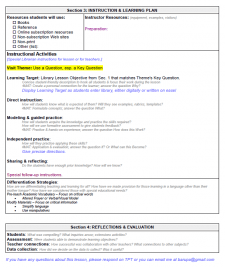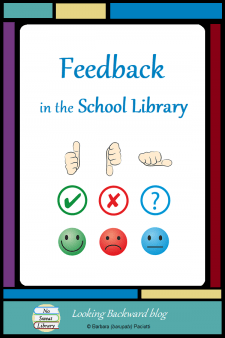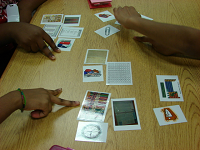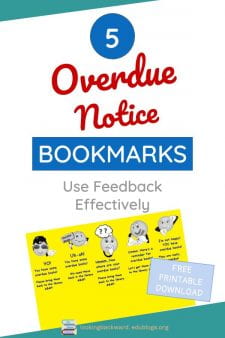 The Hack Learning Series is a series of books by educators who see big problems, and have figured out simple solutions to implement within our own classrooms and school libraries. The books are so reasonably priced a teacher can afford them. As I read my “Hack” books, I realize I’ve been “hacking” the prevailing methods in my school library for years!
The Hack Learning Series is a series of books by educators who see big problems, and have figured out simple solutions to implement within our own classrooms and school libraries. The books are so reasonably priced a teacher can afford them. As I read my “Hack” books, I realize I’ve been “hacking” the prevailing methods in my school library for years!
After certifying and moving into a school library position, I suddenly had so much more “stuff” to manage. My focus shifted to “The Library” but, without a clear strategy, my library management suffered. Then, with only intermittent visits with classes, I lost focus as “a Teacher,” and my library lessons with students weren’t successful, either.
After a disastrous first couple years, I regained my focus and and my purpose. I see in listserv posts and Facebook groups that other brand new librarians have this same problem, so here are the 5 “hacks” that improved my entire school library program.
HACK #1: Get rid of overdue book fines.
One of my wisest decisions for creating a reading culture in our school was to eliminate overdue book fines. A kid is far more important than a book—certainly more important than getting a few cents for an overdue fine. Furthermore, fines just don’t serve any positive purpose:
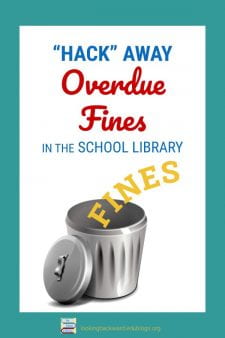
- Kids hang on to overdue books instead of returning them because they can’t pay fines in order to check out new books; thus, kids aren’t reading and books aren’t circulating.
- Fines don’t “build responsibility.” For well-off kids the paltry amount is of no consequence and when poor kids have to decide if they’ll still have money to buy lunch, that’s not responsibility, that’s sacrifice. Offering “fine forgiveness” incentives to get overdues back is not only unfair to kids who’ve been paying fines, but undermines the reasoning about “building responsibility.”
- Due dates pass before teachers can bring classes back to the library and some aren’t willing to release kids from class just to return a book on time. Kids have more pressing concerns than getting to their lockers for an overdue book during such short passing times between periods.
- In my case—and maybe for you—the public library doesn’t charge overdue fines, even for adults, so why would my public school charge kids?
- Collecting fines is time-consuming work for us with little benefit, either monetarily or promotionally. We can’t continue to use overdue fines as an excuse to “raise money for the library.” There are more positive ways to do that.
Initially I’d override the overdue fine alert, but my principal supported my decision to eliminate fines, so there was no pushback at the district level and the system admin removed fines from our school library altogether. Even now with an overdue book, I check out a new book to a student with a reminder about the overdue, because we must never discourage a child from reading!
HACK #2: Establish silent reading and invited book checkout.
From kindergarten through high school, teachers bring students to our libraries to quickly grab a book, check it out, and return to the classroom. Instead, our goal as School Librarians must be to give students the time they need to find something they want to read and then give them more time to begin reading to make sure it’s what they want.
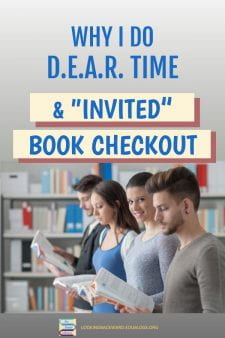 I establish a standard checkout procedure at the very first library visit and we follow it for every visit at every grade level for the entire school year. After students find their book(s), they return to their seat and silently begin reading—we call it DEAR (Drop Everything And Read). When students are settled, I go to the library seating area and quietly invite students at a couple tables, depending on numbers, to follow me to the circulation desk and check out. They line up single file, continuing to read as the line moves up until I check out their book, and then they return to their seat.
I establish a standard checkout procedure at the very first library visit and we follow it for every visit at every grade level for the entire school year. After students find their book(s), they return to their seat and silently begin reading—we call it DEAR (Drop Everything And Read). When students are settled, I go to the library seating area and quietly invite students at a couple tables, depending on numbers, to follow me to the circulation desk and check out. They line up single file, continuing to read as the line moves up until I check out their book, and then they return to their seat.
When that group is done, I go over and quietly invite a couple more tables for checkout, continuing until every student has checked out. This is an orderly process with only 8-10 students checking out at a time, and I avoid the noise and turmoil typical of whole-class book checkout. It actually takes less time, even with double classes in the library.
Silent reading time during checkout allows students to become immersed in the story and they finish more books faster. My ELA teachers bring classes to the library every other week and, rather than return to the classroom, they remain in the library the entire period for DEAR. The real value of this Hack came near the end of each school year: with this recurring free reading time, our State Reading Test scores moved steadily upward!
HACK #3: Do Dewey Decimal Orientation with Math classes.
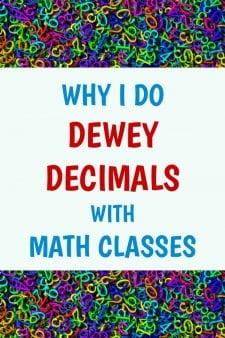 My eye-opener about Dewey Decimal lessons was during an incredibly boring orientation my 2nd year as a School Librarian: I suddenly realized DDC is for me to know for organizing books, not for students to know for finding one. They just need to know how to locate a number on a shelf, and what better class for a lesson on numbers than Math?
My eye-opener about Dewey Decimal lessons was during an incredibly boring orientation my 2nd year as a School Librarian: I suddenly realized DDC is for me to know for organizing books, not for students to know for finding one. They just need to know how to locate a number on a shelf, and what better class for a lesson on numbers than Math?
My 3rd year I created a Library Lesson for 6th grade Math and the following year I created one for 7th grade Math. We have few opportunities to bring Math classes into the library, and not only are these some of my favorite Library Lessons, the Math teachers are excited to have a fun, non-graded review where they can see which students are having trouble—they come to me to ask when they can bring their classes in! I wrote more about this Hack in a prior post, Do We Teach Dewey … or Don’t We?
HACK #4: Use Content-Area Standards as the basis for Library Lessons.
 I cringe when I see library lessons that have no relationship to what students are doing in their classroom. When I first realized my Library Lessons needed an authentic curriculum connection, I created a Library Lesson Planner that begins with Content-Area Curriculum Standards and then adds National School Library Standards. Every section of my Library Lesson Planner begins with content-area criteria so the lesson is an integral part of classroom learning. Teachers realize my value as a Teaching Colleague when I bring them a Library Lesson Plan based on their lesson plans. As a result, my collaborations increased, my library use increased, and my lessons were actually meaningful and helpful for both students and teachers!
I cringe when I see library lessons that have no relationship to what students are doing in their classroom. When I first realized my Library Lessons needed an authentic curriculum connection, I created a Library Lesson Planner that begins with Content-Area Curriculum Standards and then adds National School Library Standards. Every section of my Library Lesson Planner begins with content-area criteria so the lesson is an integral part of classroom learning. Teachers realize my value as a Teaching Colleague when I bring them a Library Lesson Plan based on their lesson plans. As a result, my collaborations increased, my library use increased, and my lessons were actually meaningful and helpful for both students and teachers!
Try my Library Lesson Planner! Just download it from my FREE Librarian Resources page.
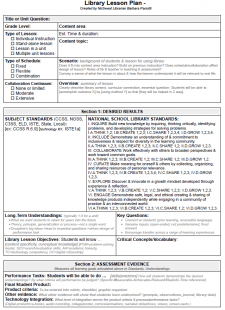 |
HACK #5: Create a Curriculum Matrix for Information Literacy Lessons.
We school librarians see young children perhaps once a week and the older students become, the less we see them, maybe only a few times during the school year. How can we build Information Literacy skills in students with such sporadic visits? I realized I could scaffold short lessons throughout each school year and across the 3 years I have our middle school students, so by the time they leave they’ll be prepared for their next stage of education and library use. I needed to know when to do which lessons with which subject areas, so I created a Library Lesson Curriculum Matrix, a visual guide to track intermittent lessons so they fit together into a comprehensive program for Information Literacy instruction.
I use a separate grid for each grade level with each week of school along the top and each subject area down the side. I examine curriculum guides and identify a unit that could benefit from a library visit. I highlight the time period for that subject’s unit on its row, and write in the name of the unit and the assignment. Then I fill in the Info-Lit skills that can be introduced or reviewed. 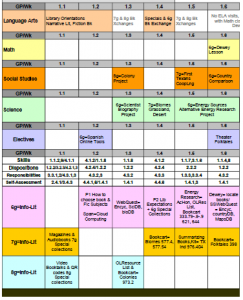 At right is a composite example of an older version of my Library Lesson Matrix for part of the 1st grading period. My Matrix occasionally changes as standards and course curricula change, but I’m able to maintain a broad view of Information Literacy visits.
At right is a composite example of an older version of my Library Lesson Matrix for part of the 1st grading period. My Matrix occasionally changes as standards and course curricula change, but I’m able to maintain a broad view of Information Literacy visits.
At the start of each grading period I go to each teacher whose subject appears for that span in my Matrix and propose a collaborative lesson. I bring a print version of my Matrix—so teachers see what a school librarian’s job is all about—and a printed Library Lesson Plan I’ve prepared that incorporates their unit Standards and activities. I make it pretty easy for them to say “Yes, indeed, let’s do this!”
KEEP HACKING
So, there you have it, my 5 Hacks for a School Library: simple, practical changes that challenge “what is” and fix problems we continue to wrestle with, whether we’re brand new or have been in libraries for decades. If you have some “hacks” you’d like to share, please share them in the comments below!
For a real treat, we now have our very own Hack book: Hacking School Libraries: 10 Ways to Incorporate Library Media Centers into Your Learning Community, written by Kristina Holzweiss and Stony Evans. I encourage you to look into other Hack Learning Series books, too, and become inspired by changes you can make in your library or classroom to fix seemingly big problems in an innovative way.
![]()

